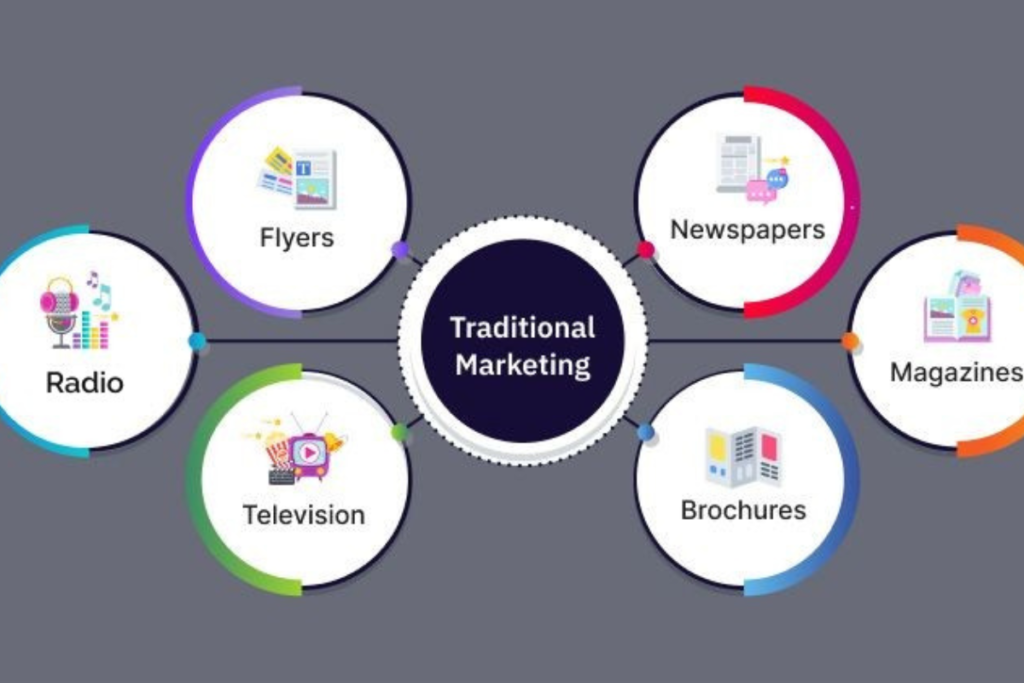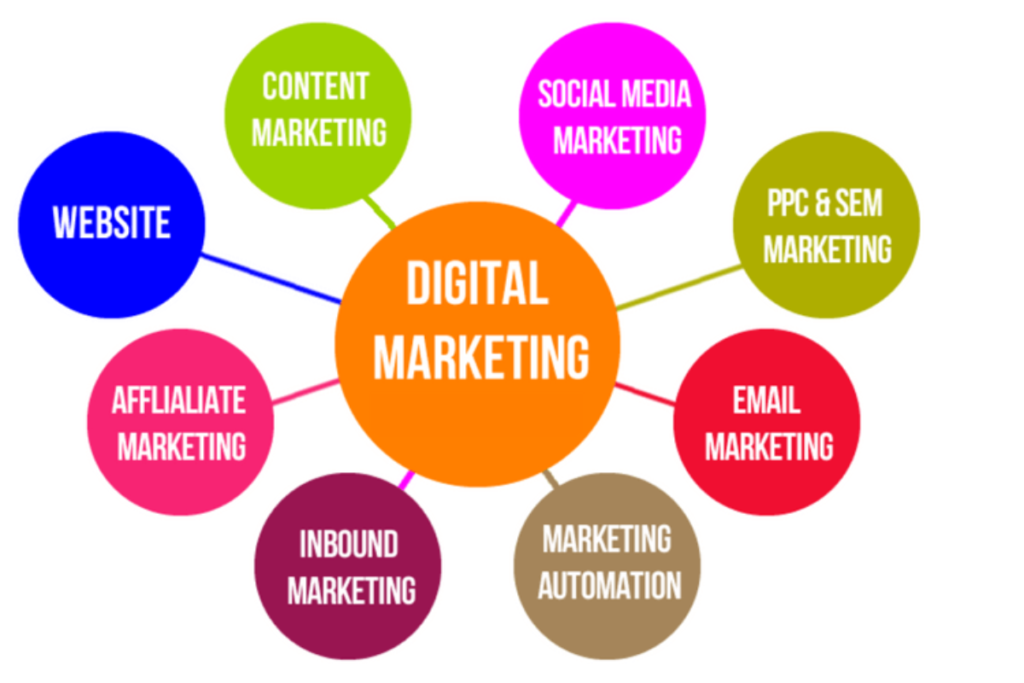Introduction
In the ever-evolving landscape of marketing, the age-old debate of Traditional V/s Digital Marketing stands as a critical juncture for businesses seeking to navigate the realm of customer engagement and brand promotion. As we delve deeper into this dynamic comparison, it becomes evident that the best marketing strategy is not an either-or choice, but rather a synergistic fusion of both worlds. This fusion, offering the best of traditional and digital marketing, empowers organizations to effectively connect with their audience, maximize impact, and stay at the forefront of the marketing game. Join us on this journey as we explore the intricacies of Traditional V/s Digital Marketing, and unveil the pivotal role they play in today’s marketing landscape
What is Traditional Marketing?
Traditional Marketing, often referred to as “Traditional V/s Digital Marketing,” represents the offline facet of marketing. It leverages platforms such as print media, radio, television, hoardings, and more for promotional purposes. The core principle behind Traditional Marketing is to engage a wide audience, with the primary goal of generating leads. It’s worth noting that Traditional Marketing remained a prominent marketing technique until the 1990s. However, following the internet revolution during that era, the relevance of Traditional Marketing started to diminish. Nevertheless, in the ongoing debate of Traditional V/s Digital Marketing, the undeniable strength of Traditional Marketing lies in its capacity to ensure that consumers cannot simply ignore the advertisements within this sphere.
At this very moment, master the art of digital marketing! Consider taking the Best Digital Marketing course.
Types of Traditional Marketing

- Broadcasting
Broadcasting entails the simultaneous transmission of identical content to a large audience, typically through mediums like television and radio.
2. Telemarketing
Telemarketing, also referred to as inside sales, involves making unsolicited phone calls to potential consumers in an effort to promote and sell goods or services.
3. Print Media
Print Media encompasses the physical versions of books, periodicals, journals, magazines, and newsletters that are distributed in the form of paper publications.
4. Window Displays and Signs
This involves showcasing products in the entrance area of a retail store through visually appealing window displays and signs.
5. Outdoor Marketing
Outdoor marketing encompasses any form of advertising designed to capture the public’s attention when they are outside, with billboards being the most prevalent type within this category, though other variations also exist.
What is Digital Marketing?
Digital Marketing, in the ongoing discussion of Traditional V/s Digital Marketing, serves as the comprehensive marketing approach through which businesses connect with their target audience via means such as advertisements, web applications, emails, search engines, mobile apps, influencer partnerships, and various paid promotions on social media.
Crucially, Digital Marketing derives its power from the internet and the advent of smartphones. When harnessed skillfully and effectively, these Digital Marketing strategies have the potential to drive any enterprise to excel in today’s competitive landscape, further underscoring the distinctions between Traditional V/s Digital Marketing.
Types of Digital Marketing

- Content Marketing Content Marketing places its primary emphasis on creating valuable content and then disseminating it to a specific target audience. The ultimate goal is to direct customers to your platform and actively engage them.
- Search Engine Optimization (SEO) SEO, as highlighted in our SEO Course, centers on optimizing content with the aid of various SEO tools to ensure its relevance to your intended audience. This process is employed to generate organic traffic to your website through search engines.
- Search Engine Marketing (SEM) Search Engine Marketing is geared toward driving traffic through paid methods, involving payments for visibility on search engines.
- Social Media Marketing (SMM) Social Media Marketing leverages social media platforms to resonate with your designated target audience, while also fostering and nurturing customer relationships.
- Pay-Per-Click Advertising (PPC) In PPC, the marketing team incurs costs for each click on their advertisements.
- Affiliate Marketing Affiliate Marketing centers on collaborations between individuals and businesses, wherein they assist companies in generating traffic. Affiliates receive commissions each time a customer clicks on their links, whether on a webpage or blog.
- Email Marketing The strategy of Email Marketing is geared towards sending emails to both existing and potential customers to enhance engagement.
- Instant Messaging Marketing (IMM) IMM is a strategy concentrated on sending instant messages to your customer base.
Traditional Marketing vs Digital Marketing The 7 Key differences
| 7 Key differences | Traditional Marketing | Digital Marketing |
|---|---|---|
| Definition | Conventional methods of approaching customers using print marketing, outdoor marketing, broadcasting, referral marketing, one-to-one marketing, etc | Connecting with customers through electronic media and social media platforms |
| Medium of Communication | Relies on offline channels such as print media, television, radio, billboards, and direct mail. | Utilizes online platforms, including websites, social media, email, search engines, and mobile apps |
| Reach and Targeting | Often has a broader but less targeted reach, making it challenging to pinpoint specific demographics | Offers precise targeting options, enabling businesses to reach specific audiences based on demographics, behaviors, and interests |
| Interaction and Engagement: | Typically involves one-way communication, where consumers have limited interaction with the content. | Facilitates two-way communication, allowing for real-time interaction and engagement between businesses and customers. |
| Cost and ROI: | Tends to be more expensive, and measuring the return on investment (ROI) can be challenging. | Generally offers cost-effective solutions and provides more accessible methods for tracking and analyzing ROI. |
| Flexibility and Timing: | Requires significant lead time for planning and execution, making it less adaptable to changing circumstances. | Allows for real-time adjustments, making it highly adaptable and responsive to market dynamics. |
| Content and Creativity: | Often relies on static content and design, limiting the creativity and dynamic aspects of advertisements. | Encourages dynamic, multimedia content, enabling businesses to be more creative and engaging. |
| Global vs. Local Impact: | Primarily targets local or regional audiences and may not have a significant global reach. | Offers the potential to reach a global audience, breaking geographical boundaries. |
Advantages of Digital Marketing over Traditional Marketing.
Let’s examine the comparative aspects of Traditional V/s Digital Marketing. Traditional Marketing, by and large, follows more conventional methods such as billboards, newspaper advertisements, and radio broadcasts, and it tends to be somewhat one-sided. In contrast, Digital Marketing introduces a two-way communication channel, offering numerous advantages.
Digital Marketing promotes meaningful interactions, allowing sellers to actively receive and respond to feedback on an ongoing basis. Consequently, it elevates credibility, nurtures brand loyalty, and enhances customer satisfaction.
While Traditional Marketing, with its demographic targeting limitations, possesses a significant advantage, it also carries certain drawbacks. The presentation plays a pivotal role, where a compelling presentation can lead to success, but a subpar or average one can result in failure. However, Digital Marketing operates differently. It thrives on trustworthy content with valuable features to capture the global audience’s hearts.
A closer examination of Digital V/s Traditional Marketing reveals that Traditional Marketing operates as a relatively static system, whereas Digital Marketing functions as a dynamic system. Digital Marketing not only accommodates the concept of “pull” marketing, where consumers actively seek out content, but also supports “push” marketing, where content is delivered to customers without their active search for information.
Pros and cons of Traditional Marketing:
Pros
- Can easily capture the attention of customers
- Exhibit brand stability and security
- Are effective at targeting elderly customers
- Create quick impact effortlessly
- Are more memorable than digital advertising
- Have a better reach in the local market
- Can be used to target areas with less development and no internet connection
- Can be directly registered in the minds of customers through repeated broadcasting
- Have the possibility of word-of-mouth marketing.
Cons
- Are highly expensive
- Make it difficult to understand the attitudes and preferences of customers
- Involve one-way communication
- Are a time-consuming process
- Make it very difficult to analyze and measure strategies and results
- Only target local audiences
- Make it difficult to understand whether they have reached the right customer
- Have demographic restrictions.
Pros and cons of Digital Marketing
Pros
- Digital marketing is a cost-effective and efficient approach.
- It provides equal opportunities for businesses of all sizes.
- It offers a high return on investment.
- It enables better lead generation and conversion rates.
- It is easy to connect with customers through digital channels.
- It increases brand awareness in the market.
- The results of digital marketing campaigns can be measured and tracked accurately.
- It promotes better engagement with customers.
- Digital marketing allows for personalization and easy targeting of specific customer segments.
- It facilitates connection with the global market and customers worldwide.
- It enables direct communication between businesses and their audience.
- Creative content can be used to engage customers effectively.
Cons
- Advertisements and promotions can be annoying, leading customers to use ad blockers or premium services without pop-ups or banner ads.
- With numerous brands competing in the digital marketing arena, it can be difficult to stand out and make an impression on the audience.
- Digital marketing strategies are not permanent and keep evolving over time.
- Each type of digital marketing requires its own set of experts.
- Continuous evaluation is necessary to ensure the efficiency and effectiveness of the implemented digital marketing strategies
Which Marketing is best for you? Digital Marketing or Traditional Marketing
There is no clear-cut response to this query. The optimal approach for most businesses involves finding a well-balanced blend of Traditional V/s Digital Marketing. When these two strategies are employed in tandem, it enhances the efficiency of the overall marketing process.
As we’ve examined the advantages and disadvantages of both methods, the ultimate choice hinges on your comprehension of the situation and your specific requirements. You must factor in your budget constraints and the characteristics of your target market. The pivotal aspect is gaining a deep understanding of your audience.
Conclusion
The debate between traditional Vs. digital marketing continues to captivate organizations worldwide. While digital marketing has undoubtedly gained immense popularity and success in recent times, it is important to recognize that a combination of both approaches remains the most effective choice for successful organizations. By integrating the strengths of both traditional Vs. digital marketing strategies, organizations can maximize their marketing efforts and effectively engage with diverse target audiences.
